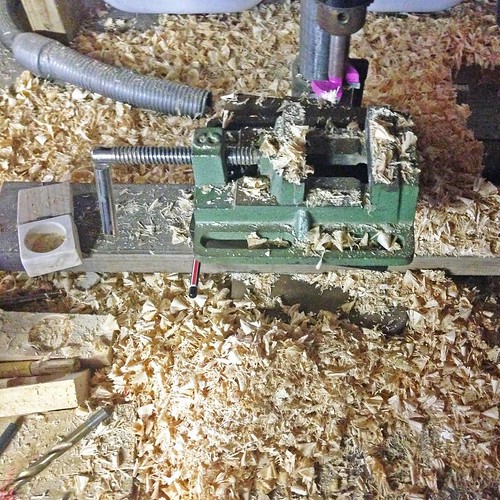The inhibition of Chebulinic acid web autophagy suppresses their therapeutic effectiveness. Autophagy also can be activated as a pro-survival response to market therapeutic resistance to cytotoxic therapy. And also the inhibition of autophagy enhances PubMed ID:http://jpet.aspetjournals.org/content/122/3/343 drug- or radiation-induced cell death as we have reported. Molecules involved inside the regulation of the 9 / 16 MicroRNA Profiling throughout 5-FU-Induced Autophagy doi:ten.1371/journal.pone.0114779.t002 autophagic course of action have emerged as promising targets for revolutionary anticancer therapies. Autophagy is actually a tightly regulated, conserved catabolic process. Right after induction, components of your cytoplasm  are sequestered into characteristic ten / 16 MicroRNA Profiling through 5-FU-Induced Autophagy 11 / 16 MicroRNA Profiling for the duration of 5-FU-Induced Autophagy Fig. three. qRT-PCR validation of altered expression of miRNAs under 5-FU treatment and starvation in human colon cancer cells. 3 sorts of human colon cancer cell lines, HT29, DLD1 and HCT116, were treated as described in Fig. 2. qRT-PCR was performed to validate the alteration on the expression of hsa-miR-302a-3p, hsa-miR-548ah-5p, hsa-miR-30a-5p, hsa-miR-23-3p, hsa-miR-195a-5p and hsa-let-7c-5p beneath 5-FU therapy and starvation. Information are shown because the imply SD. p,0.05. Experiments have been repeated three occasions with reproducible final results. doi:ten.1371/journal.pone.0114779.g003 double-membrane
are sequestered into characteristic ten / 16 MicroRNA Profiling through 5-FU-Induced Autophagy 11 / 16 MicroRNA Profiling for the duration of 5-FU-Induced Autophagy Fig. three. qRT-PCR validation of altered expression of miRNAs under 5-FU treatment and starvation in human colon cancer cells. 3 sorts of human colon cancer cell lines, HT29, DLD1 and HCT116, were treated as described in Fig. 2. qRT-PCR was performed to validate the alteration on the expression of hsa-miR-302a-3p, hsa-miR-548ah-5p, hsa-miR-30a-5p, hsa-miR-23-3p, hsa-miR-195a-5p and hsa-let-7c-5p beneath 5-FU therapy and starvation. Information are shown because the imply SD. p,0.05. Experiments have been repeated three occasions with reproducible final results. doi:ten.1371/journal.pone.0114779.g003 double-membrane  vesicles generally known as autophagosomes. Subsequently, autophagosomes fuse with late endosomes or lysosomes, forming the autolysosome. Exposure with the inner compartment to lysosomal hydrolases causes degradation in the cytoplasmic cargo, along with the resulting degradation products are then released into the cytosol for recycling. Tight handle of autophagy is crucial for cell homeostasis and response to cellular anxiety. A large family of core autophagy regulators, the AuTophaGy -related genes, serves to coordinately regulate the stepwise progression of autophagy from autophagy induction to vesicle nucleation, vesicle elongation, retrieval and fusion. Additionally, a diverse and complex network of upstream signaling pathways contribute to autophagy regulation such as the phosphatidylinositol 3 kinase, RAS-proto-oncogene and AMP-activated protein kinase pathways, lots of of which converge at the mammalian target of rapamycin complicated 1, a essential adverse regulator of autophagy signaling. In our experiment, 27 miRNAs that potentially target genes regulating autophagy were found to be upregulated after 5-FU therapy or starvation. Pathway evaluation recommended that the mTOR signaling pathway was considerably identified by these miRNAs. It was previously demonstrated in breast cancer cells that nutrient starvation results in an increase in autophagy by means of inhibition of mTOR. Our results also strongly supported this effect in the course of 5-FU-induced autophagy in colon cancer cells. Amongst these miRNAs, the predicted target genes of hsa-miR-99b-5p Finafloxacin included mTOR. And also the increase of this miRNA upon two forms of autophagy induction was substantial, five.624 and six.243 times larger than the control. Hsa-miR-99b-5p warrants additional investigation in the regulation of autophagy in 5-FU therapy in human colon cancer. In addition to the mTOR network, the beclin1 network was also reported to regulate autophagy in breast cancer. The Bcl2 family members blocks starvationinduced autophagy by interacting with the BH3 domain of Beclin1 and are damaging regulators of autophagy. In our experiment, hsa-let-7c-5p, hsa-miR-1955p, hsa-miR-23a-3p, hsa-miR-15a-.The inhibition of autophagy suppresses their therapeutic effectiveness. Autophagy also can be activated as a pro-survival response to promote therapeutic resistance to cytotoxic therapy. As well as the inhibition of autophagy enhances PubMed ID:http://jpet.aspetjournals.org/content/122/3/343 drug- or radiation-induced cell death as we’ve reported. Molecules involved within the regulation of your 9 / 16 MicroRNA Profiling throughout 5-FU-Induced Autophagy doi:10.1371/journal.pone.0114779.t002 autophagic approach have emerged as promising targets for innovative anticancer therapies. Autophagy is actually a tightly regulated, conserved catabolic course of action. Right after induction, parts with the cytoplasm are sequestered into characteristic ten / 16 MicroRNA Profiling throughout 5-FU-Induced Autophagy 11 / 16 MicroRNA Profiling for the duration of 5-FU-Induced Autophagy Fig. 3. qRT-PCR validation of altered expression of miRNAs under 5-FU therapy and starvation in human colon cancer cells. 3 kinds of human colon cancer cell lines, HT29, DLD1 and HCT116, had been treated as described in Fig. two. qRT-PCR was performed to validate the alteration on the expression of hsa-miR-302a-3p, hsa-miR-548ah-5p, hsa-miR-30a-5p, hsa-miR-23-3p, hsa-miR-195a-5p and hsa-let-7c-5p under 5-FU therapy and starvation. Information are shown as the imply SD. p,0.05. Experiments had been repeated 3 occasions with reproducible benefits. doi:ten.1371/journal.pone.0114779.g003 double-membrane vesicles generally known as autophagosomes. Subsequently, autophagosomes fuse with late endosomes or lysosomes, forming the autolysosome. Exposure of your inner compartment to lysosomal hydrolases causes degradation of your cytoplasmic cargo, and the resulting degradation items are then released in to the cytosol for recycling. Tight handle of autophagy is crucial for cell homeostasis and response to cellular stress. A sizable family members of core autophagy regulators, the AuTophaGy -related genes, serves to coordinately regulate the stepwise progression of autophagy from autophagy induction to vesicle nucleation, vesicle elongation, retrieval and fusion. Also, a diverse and complex network of upstream signaling pathways contribute to autophagy regulation which includes the phosphatidylinositol three kinase, RAS-proto-oncogene and AMP-activated protein kinase pathways, many of which converge at the mammalian target of rapamycin complex 1, a crucial damaging regulator of autophagy signaling. In our experiment, 27 miRNAs that potentially target genes regulating autophagy had been identified to become upregulated right after 5-FU therapy or starvation. Pathway evaluation recommended that the mTOR signaling pathway was considerably identified by these miRNAs. It was previously demonstrated in breast cancer cells that nutrient starvation outcomes in a rise in autophagy by means of inhibition of mTOR. Our final results also strongly supported this effect through 5-FU-induced autophagy in colon cancer cells. Amongst these miRNAs, the predicted target genes of hsa-miR-99b-5p included mTOR. And the enhance of this miRNA upon two varieties of autophagy induction was important, five.624 and six.243 instances higher than the handle. Hsa-miR-99b-5p warrants additional investigation within the regulation of autophagy in 5-FU therapy in human colon cancer. As well as the mTOR network, the beclin1 network was also reported to regulate autophagy in breast cancer. The Bcl2 family blocks starvationinduced autophagy by interacting using the BH3 domain of Beclin1 and are adverse regulators of autophagy. In our experiment, hsa-let-7c-5p, hsa-miR-1955p, hsa-miR-23a-3p, hsa-miR-15a-.
vesicles generally known as autophagosomes. Subsequently, autophagosomes fuse with late endosomes or lysosomes, forming the autolysosome. Exposure with the inner compartment to lysosomal hydrolases causes degradation in the cytoplasmic cargo, along with the resulting degradation products are then released into the cytosol for recycling. Tight handle of autophagy is crucial for cell homeostasis and response to cellular anxiety. A large family of core autophagy regulators, the AuTophaGy -related genes, serves to coordinately regulate the stepwise progression of autophagy from autophagy induction to vesicle nucleation, vesicle elongation, retrieval and fusion. Additionally, a diverse and complex network of upstream signaling pathways contribute to autophagy regulation such as the phosphatidylinositol 3 kinase, RAS-proto-oncogene and AMP-activated protein kinase pathways, lots of of which converge at the mammalian target of rapamycin complicated 1, a essential adverse regulator of autophagy signaling. In our experiment, 27 miRNAs that potentially target genes regulating autophagy were found to be upregulated after 5-FU therapy or starvation. Pathway evaluation recommended that the mTOR signaling pathway was considerably identified by these miRNAs. It was previously demonstrated in breast cancer cells that nutrient starvation results in an increase in autophagy by means of inhibition of mTOR. Our results also strongly supported this effect in the course of 5-FU-induced autophagy in colon cancer cells. Amongst these miRNAs, the predicted target genes of hsa-miR-99b-5p Finafloxacin included mTOR. And also the increase of this miRNA upon two forms of autophagy induction was substantial, five.624 and six.243 times larger than the control. Hsa-miR-99b-5p warrants additional investigation in the regulation of autophagy in 5-FU therapy in human colon cancer. In addition to the mTOR network, the beclin1 network was also reported to regulate autophagy in breast cancer. The Bcl2 family members blocks starvationinduced autophagy by interacting with the BH3 domain of Beclin1 and are damaging regulators of autophagy. In our experiment, hsa-let-7c-5p, hsa-miR-1955p, hsa-miR-23a-3p, hsa-miR-15a-.The inhibition of autophagy suppresses their therapeutic effectiveness. Autophagy also can be activated as a pro-survival response to promote therapeutic resistance to cytotoxic therapy. As well as the inhibition of autophagy enhances PubMed ID:http://jpet.aspetjournals.org/content/122/3/343 drug- or radiation-induced cell death as we’ve reported. Molecules involved within the regulation of your 9 / 16 MicroRNA Profiling throughout 5-FU-Induced Autophagy doi:10.1371/journal.pone.0114779.t002 autophagic approach have emerged as promising targets for innovative anticancer therapies. Autophagy is actually a tightly regulated, conserved catabolic course of action. Right after induction, parts with the cytoplasm are sequestered into characteristic ten / 16 MicroRNA Profiling throughout 5-FU-Induced Autophagy 11 / 16 MicroRNA Profiling for the duration of 5-FU-Induced Autophagy Fig. 3. qRT-PCR validation of altered expression of miRNAs under 5-FU therapy and starvation in human colon cancer cells. 3 kinds of human colon cancer cell lines, HT29, DLD1 and HCT116, had been treated as described in Fig. two. qRT-PCR was performed to validate the alteration on the expression of hsa-miR-302a-3p, hsa-miR-548ah-5p, hsa-miR-30a-5p, hsa-miR-23-3p, hsa-miR-195a-5p and hsa-let-7c-5p under 5-FU therapy and starvation. Information are shown as the imply SD. p,0.05. Experiments had been repeated 3 occasions with reproducible benefits. doi:ten.1371/journal.pone.0114779.g003 double-membrane vesicles generally known as autophagosomes. Subsequently, autophagosomes fuse with late endosomes or lysosomes, forming the autolysosome. Exposure of your inner compartment to lysosomal hydrolases causes degradation of your cytoplasmic cargo, and the resulting degradation items are then released in to the cytosol for recycling. Tight handle of autophagy is crucial for cell homeostasis and response to cellular stress. A sizable family members of core autophagy regulators, the AuTophaGy -related genes, serves to coordinately regulate the stepwise progression of autophagy from autophagy induction to vesicle nucleation, vesicle elongation, retrieval and fusion. Also, a diverse and complex network of upstream signaling pathways contribute to autophagy regulation which includes the phosphatidylinositol three kinase, RAS-proto-oncogene and AMP-activated protein kinase pathways, many of which converge at the mammalian target of rapamycin complex 1, a crucial damaging regulator of autophagy signaling. In our experiment, 27 miRNAs that potentially target genes regulating autophagy had been identified to become upregulated right after 5-FU therapy or starvation. Pathway evaluation recommended that the mTOR signaling pathway was considerably identified by these miRNAs. It was previously demonstrated in breast cancer cells that nutrient starvation outcomes in a rise in autophagy by means of inhibition of mTOR. Our final results also strongly supported this effect through 5-FU-induced autophagy in colon cancer cells. Amongst these miRNAs, the predicted target genes of hsa-miR-99b-5p included mTOR. And the enhance of this miRNA upon two varieties of autophagy induction was important, five.624 and six.243 instances higher than the handle. Hsa-miR-99b-5p warrants additional investigation within the regulation of autophagy in 5-FU therapy in human colon cancer. As well as the mTOR network, the beclin1 network was also reported to regulate autophagy in breast cancer. The Bcl2 family blocks starvationinduced autophagy by interacting using the BH3 domain of Beclin1 and are adverse regulators of autophagy. In our experiment, hsa-let-7c-5p, hsa-miR-1955p, hsa-miR-23a-3p, hsa-miR-15a-.